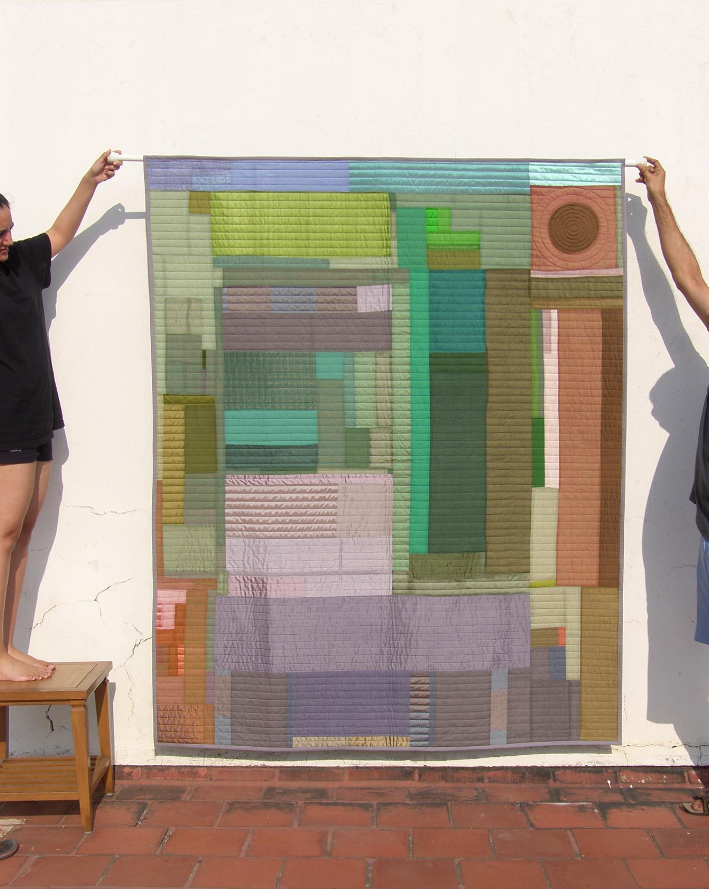Contemporary living within traditional practices of repair and reuse: in conversation with Kamala Murali, founder, Kambli studio.

Visible mending is having a moment- a shift in our value systems accounts for this upcoming trend. In the early years, there was little choice and no glory to the act of mending; fabric was expensive, and replaced rarely.
Today, however, fabric is of limited emotional and economical value; it is replaced easily. Kamala Murali’s conscience and passion drives her to work with remnant fabrics; her curiosity directed innovations of textile repair are shaping a distinctive label for her in the upcycling industry.
Chennai-based, young textile designer, Kamala Murali resonates with the vast potential of discarded pre-consumer surplus material. With Kambli studio, she is passionately communicating the merit of such scrap. Kambli- for blanket in Tamil- vies to be a distinct contemporary voice within the circular economy. “I want to make one-of-a-kind pieces”, Kamala expresses her drive to create unique products.
The inception of such design ethics took off from a printmaking studio assignment that involved working with remnant material during her time at Srishti Institute of Art, Design and Technology where she pursued her undergraduate degree in Textile design (2007-2011). Ever since, she knew that she loved to collect and live with upcycled material, and was curious to explore new ways to use “waste”. In 2012, she moved to New York City to pursue a Master’s Degree in Design History at Parsons- The New School, after which she worked in the city as a textile archivist and writer.
Returning to India in 2015, well-aware of the historic context of design and of aesthetics in the textile industry through her education and experience, she founded Kambli. Since 2018, Kambli studio makes modern patchwork quilts, cushions, wall-hangings, and runners. There is an honest, distinctive quality to their textile work that explores the capacity of ‘waste’ materials to elevate it to that of luxurious (silk and cotton), one-of-a-kind pieces made for contemporary living.

She takes inspiration from traditional practices of repair and reuse, along with ways of textile-making from India and other Eastern countries. Techniques and stories of Japanese Boro, Korean Jogakbo, Indian Siddi quilt and traditional Kantha embroidery continue to inform Kambli’ s process. Despite being rooted to a historic context, she makes a clear statement, placing herself in the context of modernism through the design decisions of her patchwork.
She often takes reference from modernist Josef Albers’ body of work and theories of colour interaction. When asked about her design decisions in terms of geometric compositions, she mentions, “The easiest way to work with pieces of fabric is piecing together of rectangular strips, this is also one of the oldest techniques within repair and reuse.” She gravitates towards minimalism. The simplicity of rectangular patches weaved together to create various visual compositions is a result of that.
Always having been drawn to colour, her compositions are resulting her understanding of colour of this affinity; simple and colour-driven. “I enjoy playing with blocks to create unique designs.” She makes a virtue of that.

“The paradox of young designers seeking inspiration from old and textiles, brings to the focus the question of what it means to be a maker in a world in which we already have too much and what do u make w the search”- Kate Irvin. It is certainly pleasing that this style of repair has regained popularity. It contradicts the current state of fast fashion where inexpensive clothing is produced rapidly by mass-market retailers in response to trends- a term that is by nature a threat to the integrity of this ethos.
There is no such specific aim with Kambli; Kamala was uncertain what the consumer response to expect when she began, she was merely intrigued by living with unique contemporary pieces and interested in knowing how other people would like to live with them. There have always been 3 key philosophies that shaped the ethos of the studio: “to re-examine: our cultural attitudes of ‘waste’, to re-imagine: our ideas of aesthetics, use design history as a map of values that may resonate with and help us: to find our grounding in the present.”

Bibliography:
1: Kate, I. (2020) The creative destruction of brokenness: Japanese boro ... - icom costume. https://costume.mini.icom.museum/wp-content/uploads/sites/10/2020/08/11.-The-Creative-Destruction-of-Brokenness_-Japanese-Boro-Repair-and-Fashion-Futures-by-Kate-Irvin.pdf (Accessed: 22 June 2023).
2: Kambli: Modern Textiles for Home & Living (no date) k a m b l i. Available at: https://www.kamblistudio.com/ (Accessed: 2 July 2023).

Leave a comment